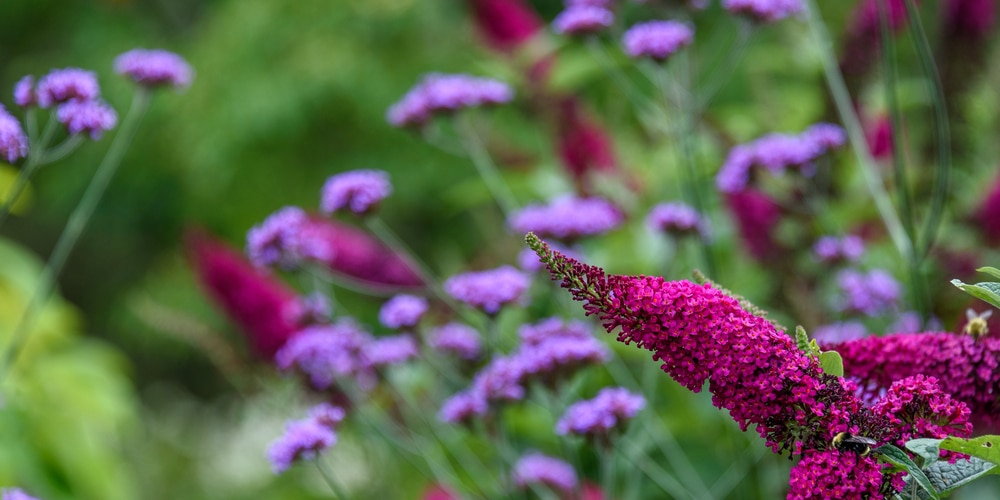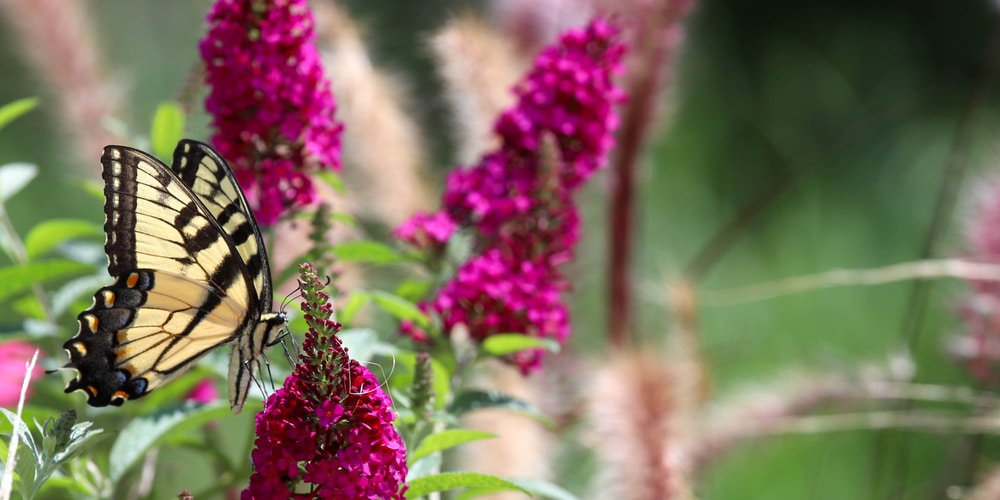The ‘Miss Molly’ butterfly bush boasts some of the most intense red-purple blooms come summertime. Also, the butterfly bush species is non-invasive and attracts hummingbirds and butterflies like bees to honey.
| Botanical Name | Buddleia x ‘Miss Molly’ |
| Common Name | Miss Molly Butterfly Bush, Summer Lilac |
| Plant Type | Perennial |
| Flower Color | Deep red-purple blooms in cone-like clusters |
| Size When Mature | 60 inches |
| Bloom Time | Summer |
| Sun Requirements | Full sun |
| USDA Hardiness Zones | 5 to 9 |
| Soil PH Range | 6.0 to 7.5 |
| Soil Type | Well-drained |
| Water Needs | Moderate |
| Native Area | China |
What you Need to Know About Miss Molly Butterfly Bush
‘Miss Molly’ is a long-lived and interesting butterfly bush variety that adds superb coloring to your garden or landscape. In the summer, intense, red-purple flower clusters spring up and invite beneficial wildlife such as butterflies and hummingbirds into your yard.
The deciduous bush keeps its color through the summer and well into fall.
The dwarf shrub only grows to about 5 feet tall (or 60 inches), but its multi-stemmed and sprawling growth habit uses up surrounding space quite well. Butterfly bushes tend to grow well as long as you put them in a location that gets full sun and well-draining soil.
How to Care for Miss Molly Butterfly Bush
Here’s everything you need to know about growing and caring for a thriving ‘Miss Molly’ Butterfly Bush
Light
The single most important requirement of growing a butterfly bush is full sunlight. ‘Miss Molly’ has the same needs and will want no less than six hours of direct sunlight each day. The species thrives in warm environments, thus their propensity to shine brightest in the summer season.
Butterfly bushes, especially the dwarf varieties, can be grown in containers. If as a houseplant, make sure Miss Molly gets the same light requirement, or else you won’t see much of the blooms. You can move your plant around so it gets at least six hours of sun daily.
Water and Soil Needs
Optimal soil pH range for Miss Molly is around 6.0 to 7.5. Butterfly bushes can tolerate a range of soil types, but it has to be well-draining, or else the shrub can easily suffer from root rot and overwatering.
Generally speaking, ‘Miss Molly’ doesn’t need too much irrigation, but you will have to water more frequently and when the days are hot. The good news is that butterfly bushes are drought tolerant and take to the heat of summer well. Only give it a drink when the top two inches of the soil is dry.
Temperature Requirements
‘Miss Molly’ Butterfly Bush is a warm-loving plant, quickly growing to its full height when exposed to such an environment. However, the shrub species is adaptable to a wide range of climates and are able to grow in USDA zones 5 through 9.
Mulching can be done in colder regions and where there are expected hard frosts. A hard prune can be done in early spring, but don’t remove more than a third so the plant won’t get stressed out and become weak.
Fertilizer
The best fertilizer to use on a Miss Molly Butterfly Bush is a slow-release fertilizer every growing season.
‘Miss Molly’ shrubs typically won’t require constant feeding and can do just fine with what’s in its soil. The deciduous plant will grow vigorously as long as it gets enough sunlight and water to support its needs.
The color and number of blooms also tend to be based on how much sun your Miss Molly butterfly bush is getting.
It won’t hurt to fertilize though, and your best course of action is a slow-release product that can give the butterfly bush a constant supply of nutrients. Make sure to follow the manufacturer’s instructions as stated on the packaging and only in spring.
Common Diseases
The beauty of ‘Miss Molly’ and butterfly bushes, in general, is that they’re not attractive to pests. However, this doesn’t mean that the species is indestructible because too much watering or waterlogged soil can bring the plant quickly to its knees.
Aside from giving it as much sun as possible, you should hold off on watering your Miss Molly too much. Butterfly bushes are susceptible to root rot, which can be caused by the shrub sitting in overly wet soil or medium. Give it well-draining soil, then water only occasionally and when you notice the topsoil getting dry.
Miss Molly Butterfly Bush Propagation
The ‘Miss Molly’ Butterfly Bush can be propagated in three ways- via seed, root division, and stem cuttings.
Seed germination and growing can take up a considerable amount of time, thus the recommended method to getting more Miss Molly butterfly bushes is to divide your existing plant or take cuttings.
Using sterilized and clean garden shears, take a branch tip cutting that’s around 4 to 6 inches long. Remove the lower leaves so roots can come out of them. Stick it into a sandy or potting soil mix, moisten the medium and place the container where it gets bright indirect sunlight.
Growth should appear several weeks after. You can plant and treat the stems as a new butterfly bush when the roots are around 2 to 4 inches long.
Dividing your butterfly bush can be done in spring, while cuttings can be taken in spring or summer.
Related Article: Do Bees Like Butterfly Bushes?


